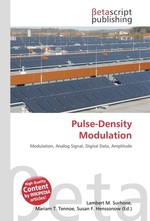Pulse-Density Modulation
Lambert M. Surhone, Mariam T. Tennoe, Susan F. Henssonow
бумажная книга
Please note that the content of this book primarily consists of articles available from Wikipedia or other free sources online. Pulse-density modulation, or PDM, is a form of modulation used to represent an analog signal with digital data. In a PDM signal, specific amplitude values are not encoded into pulses as they would be in PCM. Instead, it is the relative density of the pulses that corresponds to the analog signal's amplitude. Pulse-width modulation (PWM) is the special case of PDM where all the pulses corresponding to one sample are contiguous in the digital signal. A PDM bitstream is encoded from an analog signal through the process of delta-sigma modulation. This process uses a one bit quantizer that produces either a 1 or 0 depending on the amplitude of the analog signal. A 1 or 0 corresponds to a signal that is all the way up or all the way down, respectively. Because in the real world analog signals are rarely all the way in one direction there is a quantization error, the difference between the 1 or 0 and the actual amplitude it represents.
Данное издание не является оригинальным. Книга печатается по технологии принт-он-деманд после получения заказа.


